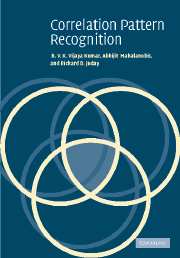Book contents
5 - Correlation filter basics
Published online by Cambridge University Press: 06 August 2009
Summary
The basic concept of correlation is illustrated in Figure 1.4 with the help of a simple character recognition example. In this figure, black pixels take on a value of 1 and white pixels take on a value of 0. Suppose we are trying to locate all occurrences of the reference or target image (C in this example) in the test image (also called the input scene). One way to achieve this is to cross-correlate the target image with the input scene. The target image is placed in the upper left corner of the input scene and pixel-wise multiplication is carried out between the two arrays; all of the values in the resultant product array are summed to produce one correlation output value. This process is repeated by shifting the target image by various shifts to the right and down, thus producing a two-dimensional (2-D) output array called the correlation output. Ideally, this correlation output would have two large values corresponding to the two “C” letters in the input scene and zeros for other letters. Thus, large cross-correlation values indicate the presence and location of the character we are looking for. However, this will not always be achievable because some other letters may have high cross-correlation. For example, letter “C” and letter “O” have large cross-correlation. One of the goals of this book is to develop methods that preserve large cross-correlation with desired targets, while suppressing cross-correlation with undesired images (sometimes called the clutter), and reducing sensitivity to noise and distortions such as rotations, scale changes, etc.
- Type
- Chapter
- Information
- Correlation Pattern Recognition , pp. 130 - 195Publisher: Cambridge University PressPrint publication year: 2005



